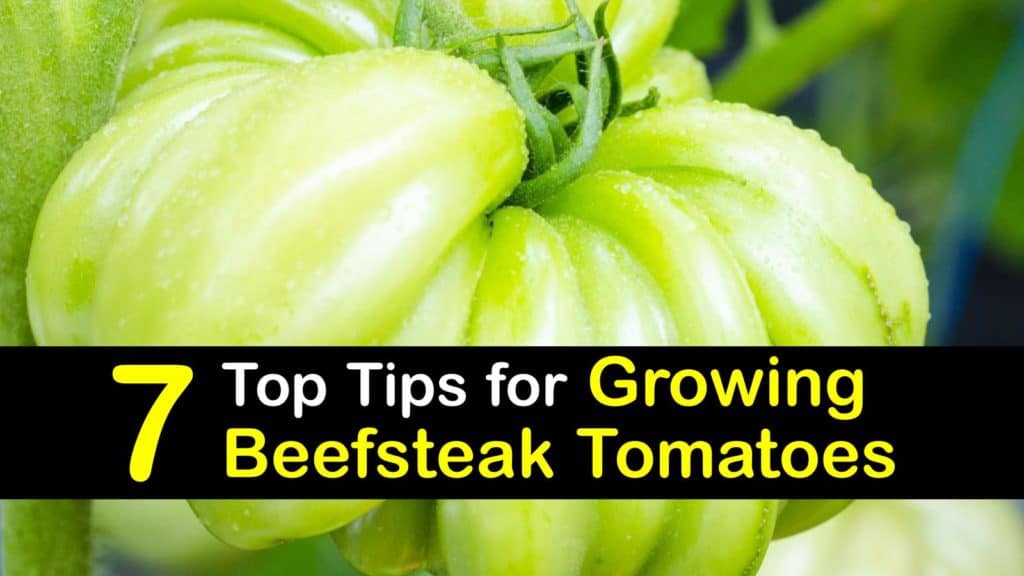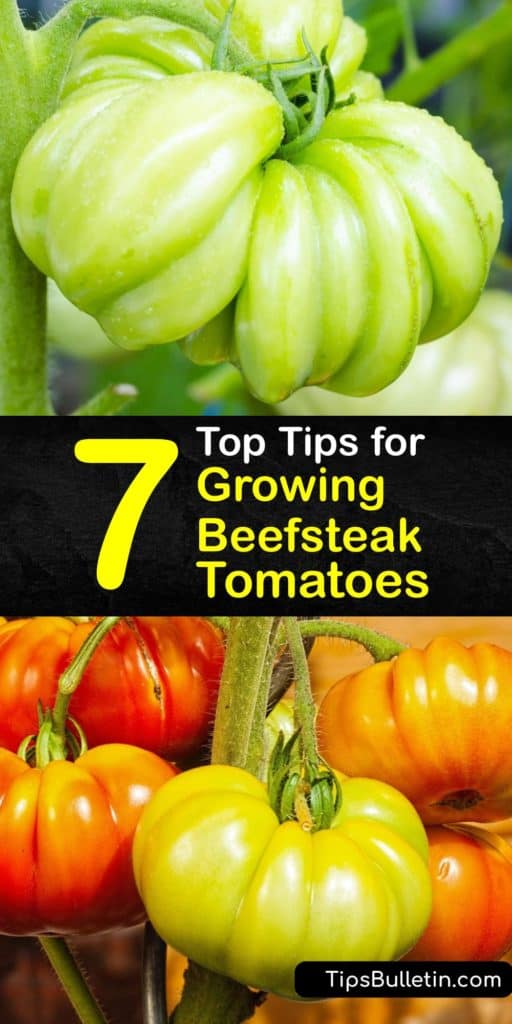Big Beef Tomatoes Get a Twin Stalk
There's a reason that beefsteak tomatoes are among the most popular tomato varieties for growing at home. These big beauties have smooth skin, a meaty texture, and an intense tomato flavor. Learn how to grow beefsteak tomatoes to enjoy thick tomato slices raw, roasted, or in sandwiches.
Tomatoes grown outside have a richer flavor and higher level of vitamin C. All tomatoes, whether grown in a greenhouse or the home garden, also contain vitamin A, fiber, and the antioxidant lycopene.
The process of growing beefsteak tomatoes starts with sowing seeds indoors. Beefsteak varieties mature in the middle to end of the growing season, often taking about 85 days to produce ripe fruit. Getting a head start indoors requires some planning but means earlier fruit production.
After you transplant your tomato seedlings outdoors, you'll need to mulch, water, and fertilize carefully to protect the plants against pests and diseases. Growing beefsteak tomatoes also involves staking and pruning.

- Tips for Planting Beefsteak Tomatoes
- Choosing a Beefsteak Tomato Variety
- Planting Beefsteak Tomatoes Indoors
- Choosing a Planting Site: Sun and Soil
- Planting Beefsteak Tomatoes Outdoors
- Watering Beefsteak Tomatoes
- Fertilizing and Mulching Beefsteak Tomatoes
- How to Grow Beefsteak Tomatoes: Staking and Pruning
- Growing Beefsteak Tomatoes: Preventing Pests and Diseases
- Common Pests for Beefsteak Tomatoes
- Harvesting Beefsteak Tomatoes
Tips for Planting Beefsteak Tomatoes
Planting and caring for beefsteak tomatoes is a suitable size project for home gardeners, regardless of whether you choose varieties of heirloom tomatoes or hybrids.
Starting the plants indoors, transplanting them, staking, and pruning all require a certain degree of effort. The reward, however, is getting to enjoy juicy, red tomatoes the same year as planting.
Beefsteaks are some of the best tomatoes to grow indoors as long as they get enough light and water.
Choosing a Beefsteak Tomato Variety
Different beefsteak varieties have different colors, sizes, harvest times, and other features. The same is true for cherry tomatoes growing tips and all other types of tomatoes. A significant choice is whether to grow a determinate or indeterminate variety.
Indeterminate tomatoes produce plentiful fruit all season long on vines that keep growing indefinitely without proper pruning. Determinate varieties are more compact and bear tomatoes over a shorter period.
Compared to hybrid tomatoes, heirloom varieties tend to have reduced disease resistance, fewer fruits per plant, and shorter shelf life. On the other hand, they're flavorful and come in unique colors.
Big beef is a popular, disease-resistant hybrid that bears many large, bright-red tomatoes. Among heirloom varieties, Brandywine is well-loved, with meaty, pink fruit.
Planting Beefsteak Tomatoes Indoors
Knowing how to grow beefsteak tomatoes from seed is the first step on your tomato-growing journey. Start tomato seeds indoors six weeks before moving the plants outdoors. Transplanting should occur one to two weeks after the last spring frost.
Insert one seed per cup in a seed tray filled with a well-drained soilless mix. Sow the seeds a half-inch deep. Expect your beefsteak tomato plants to germinate in six to 12 days.
Before the seeds germinate, keep the potting mix moist but not soggy. After germination, give the seedlings a moderate amount of water.
Choosing a Planting Site: Sun and Soil
Sun-loving tomatoes need at least eight hours of direct sunlight daily for optimal fruit production. They thrive in soil that's well-drained and slightly acidic. The ideal pH range is between 6.0 and 6.8.
If the earth is too acidic, add wood ashes, crushed limestone, bone meal, or crushed eggshells. Before transplanting your tomato seedlings, work in compost or other organic matter, and add tomato plant food or 15-30-15 fertilizer.
Avoid planting sites that have held tomatoes, peppers, potatoes, or eggplant within the past three years. Also, do not place your tomatoes next to corn, fennel, or members of the Brassicaceae family, like kale, cabbage, and broccoli.
Planting Beefsteak Tomatoes Outdoors
Transplant when your seedlings are at least eight inches tall and the soil temperature outside is at least 60℉. It's better to wait slightly longer than necessary than to transplant too early since cold temperatures can lead to deformed fruit.
Before moving your tomato plants outside permanently, harden them off by reducing the amount of water and fertilizer you give them. Choose seedlings that are sturdy, short, and dark-green as opposed to tall and yellowing.
The seedlings should not yet have flowers. Part of knowing how to grow beefsteak tomatoes is determining the ideal spacing. Plant your tomatoes in rows at least five feet apart, with the plants at least two to three feet apart within the rows.
Insert the seedlings deep into the ground—deeper than in the seed tray—to encourage healthy root development. Pack the soil gently, then water well.
Follow guidelines for beefsteak tomato plant spacing to encourage a healthier crop and discourage disease and pests.
Watering Beefsteak Tomatoes
Water your tomatoes regularly if they receive less than one inch of rainwater per week. For best results, water in the morning and close to the ground.
Provide more water once fruits start to form. For healthy tomatoes, it's essential to keep the soil evenly moist and not soggy.
Too little water can cause delayed growth and blossom end rot, while tomatoes that receive too much water may split or even explode. For increased control over watering, use a drip irrigation system.
Fertilizing and Mulching Beefsteak Tomatoes
Growing beefsteak tomatoes are heavy feeders. They benefit from fertilizer that's rich in potassium and phosphorus with a moderate quantity of nitrogen.
A plant that receives too much nitrogen may produce numerous leaves yet poor-quality fruit and be more vulnerable to foliar diseases.
As part of the proper care for a tomato plant, apply mulch between the tomato rows to discourage weeds, conserve moisture, and prevent water from splashing onto the plants. Mulch with organic matter like wheat straw. Alternatively, use black plastic mulch to warm the soil or red plastic mulch to reflect light.
How to Grow Beefsteak Tomatoes: Staking and Pruning
Support your tomato plants with a trellis, wooden stakes, or tomato cages. Install a DIY trellis before transplanting tomatoes outside or stakes or cages after planting.
Tie plants to stakes with soft string or pieces of cloth at eight to 12-inch intervals, not too tightly. Prune your indeterminate tomatoes to promote upward growth and fruit production.
Do not prune while the plant is wet since that allows fungal diseases to enter. Encourage the development of one main stem by pinching off new shoots. Remove all suckers below the first flower cluster.
To prevent disease, pluck any leaves touching the ground. Once the plant starts bearing fruit, remove the smallest tomatoes in every cluster. One month before the first fall frost, trim off all flower clusters to encourage the plant to focus on existing tomatoes.
Growing Beefsteak Tomatoes: Preventing Pests and Diseases
Beefsteak tomatoes are, unfortunately, vulnerable to several pests and diseases. To prevent common tomato diseases and pests, plant disease-resistant varieties, rotate crops, water consistently, and ensure good air circulation and adequate soil temperature.
tb1234
To get rid of aphids and bugs on tomato plants, pour a strong water stream over the tomato plants. Pick off beetles, larvae, and eggs by hand. It's also often beneficial to install row covers to discourage flea beetles.
It's also possible to make your own bug spray for a tomato plant. Garlic and neem oil are two excellent options.
Harvesting Beefsteak Tomatoes
Once you've got your plants nicely set up, you may start wondering when to pick beefsteak tomatoes. The fruits could be ready to harvest anywhere from 65 to 90 days after sowing the seeds. The timeline depends on the variety and climate.
Tomatoes have the best flavor if harvested when fully ripe. They start to ripen at their bottom end. A tomato may be ripe before achieving full color everywhere.
For example, a cherry tomato should be picked at peak redness or slightly before since it often cracks if left on the plant too long. Whatever their color, ripe tomatoes pluck easily off the vine and have smooth, waxy skin.
Beginner growers just starting their first vegetable bed may find the steps for planting beefsteak tomatoes intimidating. After all, the process involves sowing seeds, transplanting seedlings outdoors, amending the soil, setting up stakes, pruning shoots, and more.
It's true that tomatoes are not quite as simple to grow as lettuce. Nonetheless, they are manageable for the home gardener. Read up on how to grow beefsteak tomatoes to get the information and confidence you need to grow your own tasty tomatoes.

If you found these tomato growing tips helpful, please share this gardening information with your friends on Pinterest and Facebook.
longeneckercoug1956.blogspot.com
Source: https://www.tipsbulletin.com/how-to-grow-beefsteak-tomatoes/
0 Response to "Big Beef Tomatoes Get a Twin Stalk"
Post a Comment